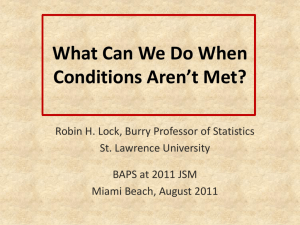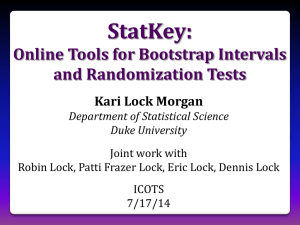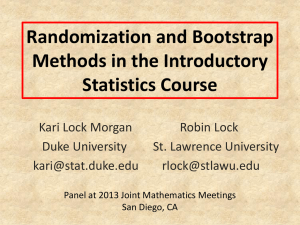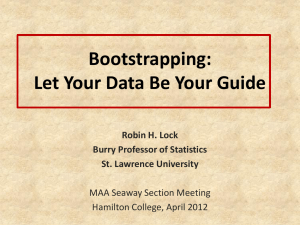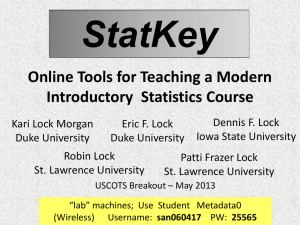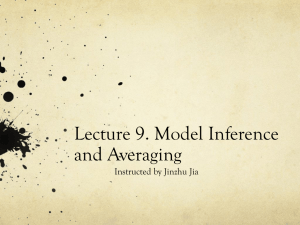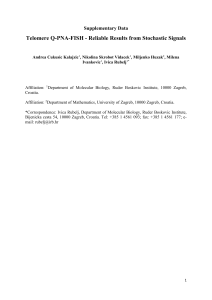Document
advertisement
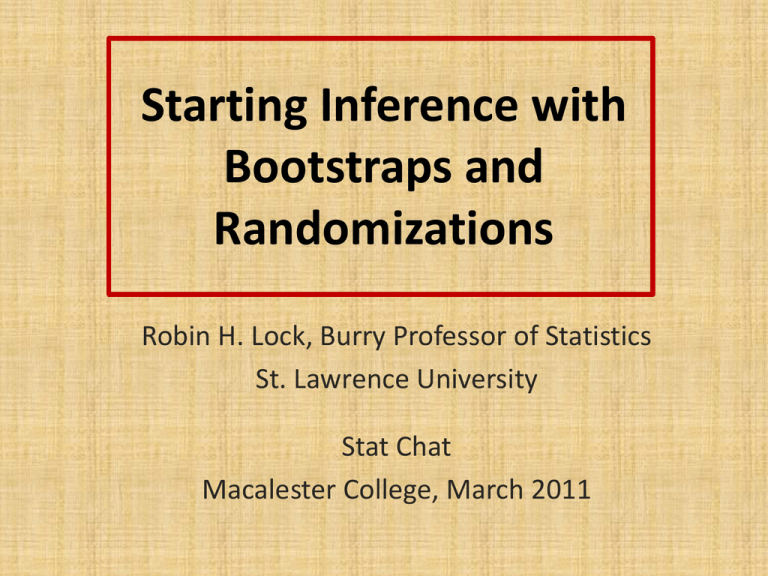
Starting Inference with Bootstraps and Randomizations Robin H. Lock, Burry Professor of Statistics St. Lawrence University Stat Chat Macalester College, March 2011 The Lock5 Team Dennis Iowa State Kari Harvard Eric UNC- Chapel Hill Robin & Patti St. Lawrence Intro Stat at St. Lawrence • • • • • • • Four statistics faculty (3 FTE) 5/6 sections per semester 26-29 students per section Only 100-level (intro) stat course on campus Students from a wide variety of majors Meet full time in a computer classroom Software: Minitab and Fathom Stat 101 - Traditional Topics • Descriptive Statistics – one and two samples • Normal distributions • Data production (samples/experiments) • Sampling distributions (mean/proportion) • Confidence intervals (means/proportions) • Hypothesis tests (means/proportions) • ANOVA for several means, Inference for regression, Chi-square tests QUIZ Choose an order to teach standard inference topics: _____ Test for difference in two means _____ CI for single mean _____ CI for difference in two proportions _____ CI for single proportion _____ Test for single mean _____ Test for single proportion _____ Test for difference in two proportions _____ CI for difference in two means When do current texts first discuss confidence intervals and hypothesis tests? Moore Agresti/Franklin DeVeaux/Velleman/Bock Devore/Peck Confidence Interval pg. 359 Significance Test pg. 373 pg. 329 pg. 486 pg. 319 pg. 400 pg. 511 pg. 365 Stat 101 - Revised Topics • • •• • • • • Descriptive Statistics – one and two samples Normal distributions Bootstrap confidence intervals Data production (samples/experiments) Randomization-based hypothesis tests Sampling distributions (mean/proportion) Normal distributions Confidence intervals (means/proportions) • Hypothesis tests (means/proportions) • ANOVA for several means, Inference for regression, Chi-square tests Toyota Prius – Hybrid Technology Prerequisites for Bootstrap CI’s Students should know about: • • • • Parameters / sample statistics Random sampling Dotplot (or histogram) Standard deviation and/or percentiles Example: Atlanta Commutes What’s the mean commute time for workers in metropolitan Atlanta? Data: The American Housing Survey (AHS) collected data from Atlanta in 2004. Sample of n=500 Atlanta Commutes CommuteAtlanta Dot Plot n = 500 𝑥 =29.11 minutes s = 20.72 minutes 20 40 60 80 100 120 140 160 Time Where might the “true” μ be? 180 “Bootstrap” Samples Key idea: Sample with replacement from the original sample using the same n. Assumes the “population” is many, many copies of the original sample. Atlanta Commutes – Original Sample Atlanta Commutes: Simulated Population Creating a Bootstrap Distribution 1. Compute a statistic of interest (original sample). 2. Create a new sample with replacement (same n). 3. Compute the same statistic for the new sample. 4. Repeat 2 & 3 many times, storing the results. 5. Analyze the distribution of collected statistics. Try a demo with Fathom Bootstrap Distribution of 1000 Atlanta Commute Means Mean of 𝑥’s=29.09 Std. dev of 𝑥’s=0.93 Using the Bootstrap Distribution to Get a Confidence Interval – Version #1 The standard deviation of the bootstrap statistics estimates the standard error of the sample statistic. Quick interval estimate : 𝑂𝑟𝑖𝑔𝑖𝑛𝑎𝑙 𝑆𝑡𝑎𝑡𝑖𝑠𝑡𝑖𝑐 ± 2 ∙ 𝑆𝐸 For the mean Atlanta commute time: 29.11 ± 2 ∙ 0.93 = 29.11 ± 1.86 = (27.25, 30.97) Quick Assessment HW assignment (after one class on Sept. 29): Use data from a sample of NHL players to find a confidence interval for the standard deviation of number of penalty minutes. Results: 9/26 did everything fine 6/26 got a reasonable bootstrap distribution, but messed up the interval, e.g. StdError( ) 5/26 had errors in the bootstraps, e.g. n=1000 6/26 had trouble getting started, e.g. defining s( ) Using the Bootstrap Distribution to Get a Confidence Interval – Version #2 27.25 Chop 2.5% in each tail Keep 95% in middle 30.97 Chop 2.5% in each tail 29.11 ± 2 ∙ 0.93 = (27.25, 30.97) Using the Bootstrap Distribution to Get a Confidence Interval – Version #2 95% CI=(27.24,31.03) 27.24 Chop 2.5% in each tail 31.03 Keep 95% in middle Chop 2.5% in each tail For a 95% CI, find the 2.5%-tile and 97.5%-tile in the bootstrap distribution 90% CI for Mean Atlanta Commute 90% CI=(27.60,30.61) Chop 5% in each tail 27.60 30.61 Keep 90% in middle Chop 5% in each tail For a 90% CI, find the 5%-tile and 95%-tile in the bootstrap distribution 99% CI for Mean Atlanta Commute 99% CI=(26.73,31.65) 26.73 Chop 0.5% in each tail 31.65 Keep 99% in middle Chop 0.5% in each tail For a 99% CI, find the 0.5%-tile and 99.5%-tile in the bootstrap distribution What About Hypothesis Tests? “Randomization” Samples Key idea: Generate samples that are (a) based on the original sample AND (a) consistent with some null hypothesis. Example: Mean Body Temperature Is the average body temperature really 98.6oF? H0:μ=98.6 Ha:μ≠98.6 Data: A sample of n=50 body temperatures. BodyTemp50 n = 50 𝑥 =98.26 s = 0.765 96 97 98 99 BodyTemp Dot Plot 100 Data from Allen Shoemaker, 1996 JSE data set article 101 Randomization Samples How to simulate samples of body temperatures to be consistent with H0: μ=98.6? 1. Add 0.34 to each temperature in the sample (to get the mean up to 98.6). 2. Sample (with replacement) from the new data. 3. Find the mean for each sample (H0 is true). 4. See how many of the sample means are as extreme as the observed 𝑥 =98.26. Fathom Demo Randomization Distribution Measures from Sample of BodyTemp50 Dot Plot 𝑥 =98.26 98.2 98.3 98.4 98.5 98.6 xbar 98.7 98.8 Looks pretty unusual… p-value ≈ 1/1000 x 2 = 0.002 98.9 99.0 Choosing a Randomization Method Example: Finger tap rates (Handbook of Small Datasets) A=Caffeine 246 248 250 252 248 250 246 248 245 250 mean=248.3 B=No Caffeine 242 245 244 248 247 248 242 244 246 241 mean=244.7 H0: μA=μB vs. Ha: μA>μB Method #1: Randomly scramble the A and B labels and assign to the 20 tap rates. Method #2: Add 1.8 to each B rate and subtract 1.8 from each A rate (to make both means equal to 246.5). Sample 10 values (with replacement) within each group. Connecting CI’s and Tests Measures from Sample of BodyTemp50 Dot Plot Randomization body temp means when μ=98.6 98.2 98.3 98.4 98.5 Measures from Sample of BodyTemp50 98.6 xbar 98.7 98.8 98.9 99.0 Dot Plot Bootstrap body temp means from the original sample 97.9 98.0 98.1 98.2 98.3 98.4 bootxbar 98.5 98.6 98.7 Fathom Demo Fathom Demo: Test & CI Intermediate Assessment Exam #2: (Oct. 26) Students were asked to find and interpret a 95% confidence interval for the correlation between water pH and mercury levels in fish for a sample of Florida lakes – using both SE and percentiles from a bootstrap distribution. Results: 17/26 did everything fine 4/26 had errors finding/using SE 2/26 had minor arithmetic errors 3/26 had errors in the bootstrap distribution Transitioning to Traditional Inference AFTER students have seen lots of bootstrap and randomization distributions… • Introduce the normal distribution (and later t) • Introduce “shortcuts” for estimating SE for proportions, means, differences, slope… Final Assessment Final exam: (Dec. 15) Find a 98% confidence interval using a bootstrap distribution for the mean amount of study time during final exams Study Hours Dot Plot 10 20 30 40 50 60 Hours Results: 26/26 had a reasonable bootstrap distribution 24/26 had an appropriate interval 23/26 had a correct interpretation What About Technology? Possible options? • Fathom/Tinkerplots xbar=function(x,i) mean(x[i]) • R b=boot(Time,xbar,1000) • Minitab (macro) • JMP (script) Try a Hands-on Breakout • Web apps Session at USCOTS! • Others? Applet Demo Support Materials? We’re working on them… Interested in class testing? rlock@stlawu.edu
